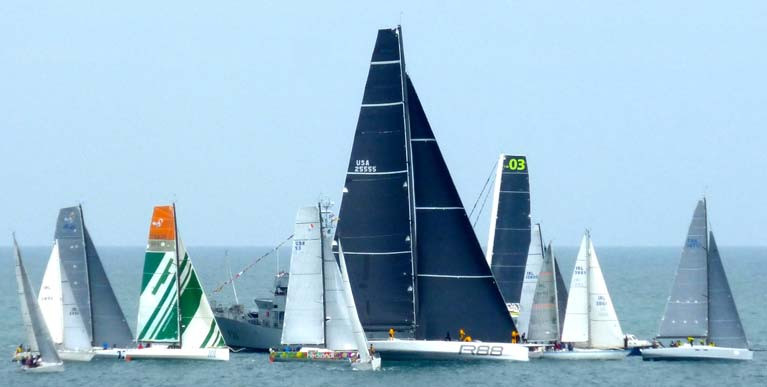This year, with the fresh sponsorship of SSE Renewables, the Round Ireland Race from Wicklow comes of age. The 21st staging of the biennial classic – now an international event, included in the Royal Ocean Racing Club’s programme and an integral part of its annual points championship – will mark four decades of exceptional enthusiasm and voluntary dedication by a relatively small sailing club in a little river mouth port, a harbour town which successfully asserts its special position and unique identity in an Irish sailing scene which otherwise tends to be dominated by four or five much larger sailing centres.
Although the entry process for 2020’s race on June 20th was only opened as recently as January 20th, confirmed entries are already pushing towards the 20 mark, and while the latest entry is the Xp44 WOW (George Sisk) from the Royal Irish YC in Dun Laoghaire, a notable feature of the early entries is their overseas range, including Hiroshi Nakajima’s classic Sparkman & Stephens 49 Hiro Maru, from the US, campaigning in Europe after last year’s Transatlantic Race.
 An American entry already in for the SSE Renewables Round Ireland Race 2020 is Hiroshi Nakajima’s 1971-vintage S&S 49 classic Hiro Maru, built-in aluminium by Palmer Johnson of Sturgeon Bay, Wisconsin, the builders of Ted Turner’s 1979 Fastnet Race winner Tenacious
An American entry already in for the SSE Renewables Round Ireland Race 2020 is Hiroshi Nakajima’s 1971-vintage S&S 49 classic Hiro Maru, built-in aluminium by Palmer Johnson of Sturgeon Bay, Wisconsin, the builders of Ted Turner’s 1979 Fastnet Race winner Tenacious
This international interest has been a central theme of the Round Ireland Race from its early days, and in some years such as 2016 when George David’s mighty mono-hull Rambler 88 and three MOD 70 trimarans established a complete raft of new records, it has been the dominant feature. But equally, for many offshore racers from clubs all round Ireland and further afield, racing round Ireland is a rite of passage, so special for some that they do it many times.
But at whatever level you participate, in whatever size of boat, there is something profound, something unique and deeply satisfying, about racing round our island home, experiencing its incredibly varied weather, its majestic coastline, its wayward tides, and the camaraderie which develops among competitors, whether as shipmates or friendly rivals. And with this 21st staging of the race, it is time to put the story in context.
Forty years ago on Saturday 28th June 1980, a varied fleet of 13 small to medium-sized cruiser-racers came to the starting line off Wicklow, and headed south with the gathering ebb tide and a summery easterly breeze in the first non-stop Round Ireland Race, a challenge which - at 704 miles – was just four miles short of being a hundred miles longer than the standard-setting Fastnet Race itself.
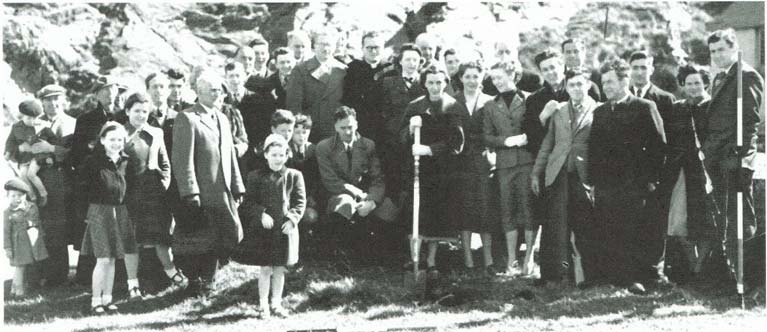 Beginnings – the ceremony to turn the first sod for the building of a clubhouse for the new Wicklow Sailing Club in 1953
Beginnings – the ceremony to turn the first sod for the building of a clubhouse for the new Wicklow Sailing Club in 1953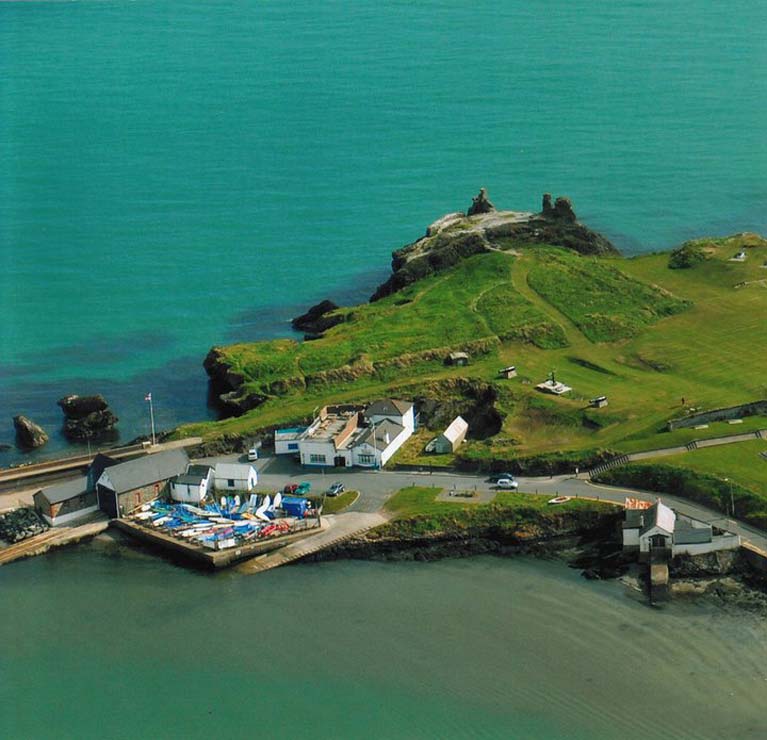 Small club, big heart – Wicklow SC (centre) and the Wicklow RNLI Station (left) provide a maritime hotspot at the head of the pier
Small club, big heart – Wicklow SC (centre) and the Wicklow RNLI Station (left) provide a maritime hotspot at the head of the pier
The organising Wicklow Sailing Club – founded as recently as 1950/51 - may have been small by comparison with many of the older history-laden Irish yacht clubs. But with a strong voluntary spirit, it punched well above its weight in being at the heart of a community in which it promoted sailing and waterfront co-operation in a picturesque but workaday port, a harbour where the dominant activities had formerly been in meeting the needs of small cargo ships, a local inshore fishing industry, and a voluntarily-supported lifeboat station.
By the late 1970s the club was a hive of activity, and in 1979 - with Harry Jordan as Commodore - in addition, its own busy weekly races it was actively involved in bringing newcomers to sailing. That year, it also ran an innovative Wicklow Yacht Rally which drew in 46 participants from all around the Irish Sea. With its testing of crews’ skills and a programme of assessment and advice by recognized experts on preparing boats for serious sea-going, it was the core event in a summer fixtures list of such varied, useful and yet enjoyable activity that the newly inaugurated “Sailing Club of the Year” competition in 1979 selected Wicklow SC to be its first winner.
But even as the successes of 1979 were being celebrated, another game-changing idea was rapidly developing. Michael Jones, a keen member of the club who served as Commodore three times - in 1972, 1984 and 1991 - was also a longtime honorary secretary of the Wicklow RNLI. With an accountancy practice in the town, he was well aware of the place’s strengths and weaknesses.
Pondering on all this, he became convinced that a major maritime event was needed to help Wicklow re-discover its deeper maritime roots, assert its individuality as a self-contained and thriving community in the face of growing Dublin commuter encroachment, and generally make its mark on the national sailing stage.
 Man of vision – Michael Jones of Wicklow
Man of vision – Michael Jones of Wicklow
Or at least that’s the way he subsequently explained how he brought the Round Ireland Yacht Race starting and finishing at Wicklow into being. Whatever the reasons, he had the idea, indeed he was consumed by it. But instead of promoting it with noisy announcements, he put at least as much energy into behind-the-scenes networking with the kind of slightly off-the-wall offshore sailing enthusiasts who had emerged with the growth of the ISORA programme and other events, together with more cruising-oriented people whom he knew would feel that a non-stop round Ireland race was an event whose time had come.
 Pre-start manoeuvres at the inaugural Round Ireland 1980 with (left to right) line honours winner Force Tension, the Shamrock class Orinoco, John Hall’s Prout catamaran, and eventual overall winner Raasay of Melfort (Brian Coad). Photo: W M Nixon
Pre-start manoeuvres at the inaugural Round Ireland 1980 with (left to right) line honours winner Force Tension, the Shamrock class Orinoco, John Hall’s Prout catamaran, and eventual overall winner Raasay of Melfort (Brian Coad). Photo: W M Nixon
At the same time, he brought key members of Wicklow Sailing Club who had shown their readiness for voluntary work along with him, and the fruits of their labour became evident on that summery Saturday afternoon off Wicklow on June 28th 1980 when 13 boats went off southwards in an easterly breeze after a rather uneven start. It was uneven because this was the first time a Round Ireland fleet became aware that the sluicing ebb off the Wicklow pierheads makes an early arrival on the line a loser’s option.
Thus although top skipper Johnny Morris of Pwllheli with Tony Vernon’s High Tension 36 Force Tension was so neatly away that his boat doesn’t appear in any of the photos of the main group starting, Half Ton ace Jim Poole of the National Yacht Club with his Ron Holland-designed Feanor almost found himself on the wrong side of the Committee Boat in that tide, and had to assert his rights on starboard gybe to make the line.
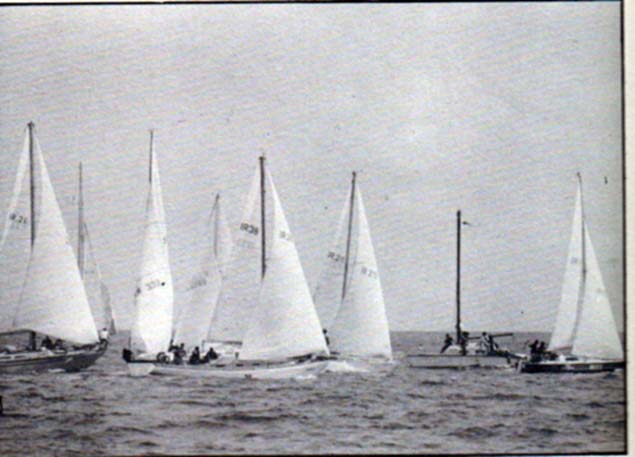 That first start in 1980 – Force Tension is already out of picture, Brian Murphy’s Hydra class Crazy Jane is next across ahead of Raasay, and Feanor is having to assert her starboard gybe rights with Partizan after under-estimating the tidal stream. Photo: W M Nixon
That first start in 1980 – Force Tension is already out of picture, Brian Murphy’s Hydra class Crazy Jane is next across ahead of Raasay, and Feanor is having to assert her starboard gybe rights with Partizan after under-estimating the tidal stream. Photo: W M Nixon
Yet in the end, although Force Tension took line honours by more than two hours from Dave FitzGerald’s Holman & Pye 41 Partizan from Galway, it was the little Feanor (whose crew included a young Enda O Coineen) which won IOR overall by an hour from Dermod Ryan’s Hustler 35 Red Velvet (RStGYC).
But when the idea of the race had been launched, Michael Jones had no idea of just how much it would appeal to an all-Ireland cross-section of established offshore racers. So, to spread the net wide, he announced from the get-go that the ultimate winner would be based not on the very competitively-oriented International Offshore Rule, but on a special Wicklow Round Ireland Handicap, and multi-hulls would also be welcome to take part.
 Making knots in the open Atlantic - the Half Tonner Feanor running smoothly off the west coast. Photo: Enda O Coineen
Making knots in the open Atlantic - the Half Tonner Feanor running smoothly off the west coast. Photo: Enda O Coineen Chasing the big ’uns – Feanor with the 41ft Partizan (Dave Fitzgerald) off the coast of Donegal in 1980. Photo: Enda O Coineen
Chasing the big ’uns – Feanor with the 41ft Partizan (Dave Fitzgerald) off the coast of Donegal in 1980. Photo: Enda O Coineen
Thus the first winner was definitely a boat with strong cruising emphasis, Brian Coad’s Rival 34 Raasay of Melfort from Dunmore East. And though none of the multihulls finished, one of their skippers, John Hall of the National YC, is the only skipper from that race of 1980 still actively campaigning, though for some years now he has been doing it in partnership with his son Brian in the J/109 Something Else.
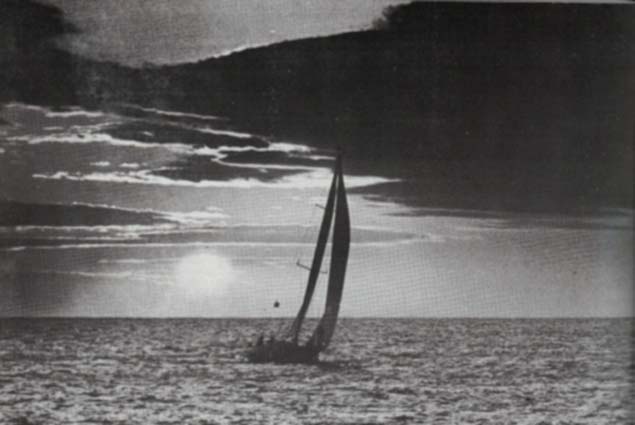 Classic finish to the first Round Ireland Race – Dave Fitzgerald’s Partizan from Galway come out of the dawn to the finish at Wicklow in 1980 to take second in line honours
Classic finish to the first Round Ireland Race – Dave Fitzgerald’s Partizan from Galway come out of the dawn to the finish at Wicklow in 1980 to take second in line honours
Either way, the race was well launched, and signs of addiction to this glorious course were well in evidence among some of the first time participants. So there was no question but that the race would be sailed again in 1982, and this time Michael Jones and his team in Wicklow SC really hit the jackpot - The Doyler came up from Crosshaven to take part with his already-legendary new Frers-designed 51ft Moonduster.
Denis Doyle and Moonduster epitomised the very spirit of Irish offshore racing, going back in a direct line to the Gull in the first Fastnet Race of 1925 with skipper Harry Donegan. Needless to say, in the time-honoured Cork sailing tradition the Doyle and Donegan families were related through marriage. Like Harry Donegan, Denis Doyle fully realised what a significant role a major sailing event could play in the economy of a small seaport town. So in Wicklow, Moonduster’s skipper and his ever-supportive wife Mary stayed near the harbour in a guesthouse in the town in the days beforehand to indicate their complete commitment to a Wicklow-based Round Ireland Yacht Race, a supportive habit they continued throughout Moonduster’s many years of racing round Ireland.
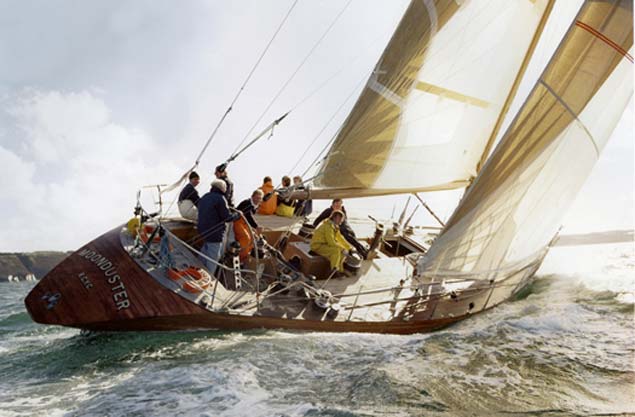 Denis Doyle helming his beloved Moonduster. His complete commitment to the Round Ireland Race as a Wicklow event from 1982 onwards played a key role in establishing the race’s success. Photo: Bob Bateman
Denis Doyle helming his beloved Moonduster. His complete commitment to the Round Ireland Race as a Wicklow event from 1982 onwards played a key role in establishing the race’s success. Photo: Bob Bateman
As a former Flag Officer of the Royal Ocean Racing Club, Moonduster’s skipper brought an element of RORC support to the event, particularly as regards pre-race scrutineering. This was very timely for the 1982 circuit, as it was a race of heavy weather with north to northeast gales making things brutal. Many boats sought shelter along the west coast, and even Moonduster had to pause for a while close under the limited shelter of Malin Head while a crewman went aloft to replace a broken halyard.
Despite that, she got round in 4 days 3 hrs 45mins and 25 seconds, taking line honours and eventually the overall win despite the slowly-changing wind direction theoretically favouring the smaller boats. As for the race’s status, it was now fully established in the offshore calendar in its convenient position in non-Fastnet years, with Moonduster becoming a round Ireland regular until Denis Doyle’s death in 2001.
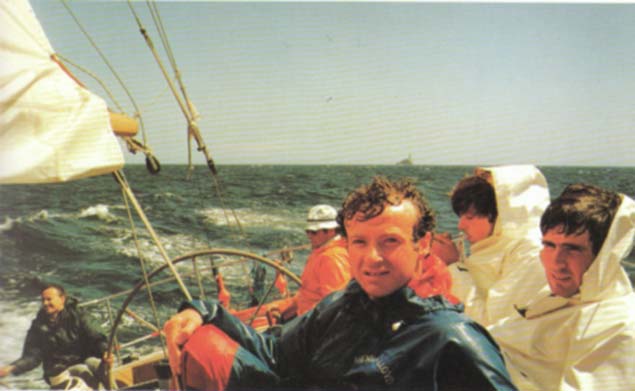 Neil Hegarty at the helm as Moonduster puts the Fastnet Rock rapidly astern in 1984’s record race – “we were seeing off an entire Irish county in every watch”.
Neil Hegarty at the helm as Moonduster puts the Fastnet Rock rapidly astern in 1984’s record race – “we were seeing off an entire Irish county in every watch”.
In 1984, The Duster had an astonishing race, with the wind favouring her at every headland such that, in the words of navigator John Bourke (who was himself later to become the RORC Commodore): “We were seeing off an entire Irish county in every watch”.
In 2020, forty years after that first tentative race, we’re looking at the 21st Round Ireland Race from Wicklow, and a bare tabulation of the winners over the years gives a hint of the many boats and hundreds – indeed thousands – of people who have been involved, people who in their most active offshore racing days defined this now-central feature of Irish sailing.
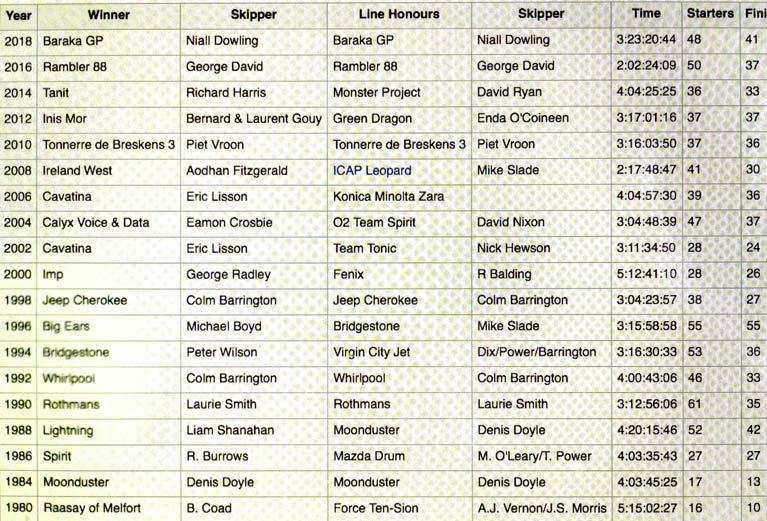 An almost-complete basic analysis – missing is 1982 when Moonduster took both line honours and the corrected time win, a feat she repeated in 1984.
An almost-complete basic analysis – missing is 1982 when Moonduster took both line honours and the corrected time win, a feat she repeated in 1984.
The stories behind this bare-bones list would fill several books and still leave out some choice stories. 1986 saw the race gain real muscle with major sponsorship from Cork Dry Gin, and in that year it was Irish Distillers own Richard Burrows himself who won (his crew including Robert Dix) sailing the Dehler db2s Spirit, while line honours were taken by the Ron Holland Maxi Drum, with owner Simon le Bon of Duran Duran on board.
The fact that all 27 starters finished reinforces memories of this as being one of the most summery races, but as Robert Dix on Spirit commented, “the summer haze was such that half the time we couldn’t see the magnificent coastlines which we knew we were racing along.
The special Dehler db2s got another look-in during 1988’s race, when Liam Shanahan’s Lightning (NYC) took the handicap win, while Moonduster had another bite at line honours. Those late 1980s were the last years in which tobacco and drink companies were still tolerated as sponsors for sports events. But the Health Police were closing in, and the Cork Dry Gin Round Ireland Race of 1990 was something of a last hurrah, as CDC’s generosity encouraged a starting line-up of 61 boats – it’s still the record turnout – and the line honours and overall winner was the legendary Lawrie Smith sailing the Maxi Rothmans and promoting Silk Cut cigarettes, his leading crew being the hyper-talented Gordon Maguire.
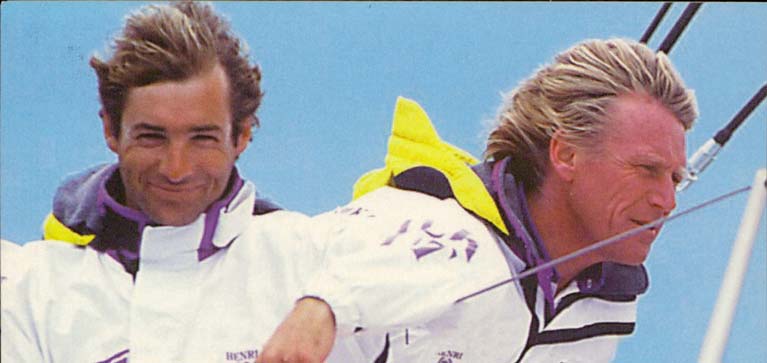 Dream team…Gordon Maguire and Lawrie Smith on the maxi Rothmans, with which they won line honours and overall in 1990’s race.
Dream team…Gordon Maguire and Lawrie Smith on the maxi Rothmans, with which they won line honours and overall in 1990’s race.
Yes indeed, boys and girls. Thirty years ago, ultra-healthy sports events such as the Round Ireland Race were being sponsored by booze companies and won by smokes, and only a few thought it all a bit odd. So the fact that for 2020 the new sponsor is a clean energy company which is hitting the optics spot on - and sending out all the right messages - tells us how far we’ve come in thirty years, even if in the end it is still the same rugged challenge of getting your boat round Ireland in a competitive timeframe.
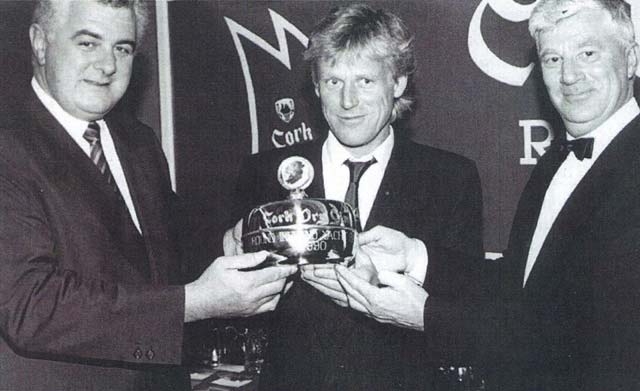 Richard Burrows (winner in 1986) with Lawrie Smith (winner in 1990) and Race Director Michael Jones
Richard Burrows (winner in 1986) with Lawrie Smith (winner in 1990) and Race Director Michael Jones
In fact, in looking at that list, you can deduce from comparing the number of finishers with the number of starters just how rough that particular race might have been, for if the race had been beset by calm, the high-rated boats tended to suffer but low-rated craft like Eric Lisson’s Noray 38 Cavatina from Cork – winner in 2002 and 2006 – knew they just had to keep plodding along and read the new wind correctly to take the honours.
If the 1980s were the era of the Dehler db2S marque, the 1990s marked high noon for the J/35. Not every boat from the generally successful J Boat range was always on the money, but even among the special ones the J/35 was very special indeed, and in 1994 (quite a stormy race) Peter Wilson of Howth won with the J/35 Bridgestone, while in the 1996 race it was the turn of a sister-ship, Big Ears from the RIYC skippered by future RORC Commodore Michael Boyd, which took the honours.
Michael Boyd’s dedication to racing round Ireland is quite something, as he’s still at it, and with good placings in the 2016 and 2018 races he is well in line for the three-race prize of a Volvo car, presumably one of the impressive new electric ones. But though the whispers for the 2020 strongly suggest a Boyd involvement, at the moment nothing is official.
Meanwhile, we could warble on for hours about what that list of winners and line honours holders tells us, but for now, we’ll be content with observing that the last truly Irish overall winner was Aodhan FitzGerald of Galway with the First 40.7 Ireland West in 2008, which is getting to be quite a long time ago.
Admittedly the most recent winner in 2018, the Ker 43 Baraka GP, was entered by Niall Dowling of the RIYC, and his navigator/tactician was our own Ian Moore, but they’re both now essentially Solent-based, as is the chartered boat. That said, perhaps we should run with the notion that the modern Irish diaspora is a matter of success and achievement which can be applied anywhere in the world.
Be that as it may, since Ireland West’s win in 2008, the internationalism of the Round Ireland Race has been underlined by the fact that the subsequent winners have been from The Netherlands (Tonnere de Breskens 3, 2010), France (Inis Mor 2012), Scotland (Tanit, 2014) and the USA (Rambler 88, 2016).
 Wicklow Sailing Club Commodores – the size of the membership can be gauged from the fact that some Commodores served more than one spell of duty, with Michael Jones filling the role three times
Wicklow Sailing Club Commodores – the size of the membership can be gauged from the fact that some Commodores served more than one spell of duty, with Michael Jones filling the role three times
From an organiser’s point of view, this is a very satisfactory state of affairs, but it does mean that the workload of running the race has increased exponentially. Michael Jones carried the torch as Race Director from 1980 until 1992, then from 1994 to 1998, Fergus O’Conchobhair took up the reins. He was succeeded by Denis Noonan from 2000 until 2010 when Theo Phelan took over.
 Fergus O’Conchobair was Race Director from 1994 to 1998
Fergus O’Conchobair was Race Director from 1994 to 1998
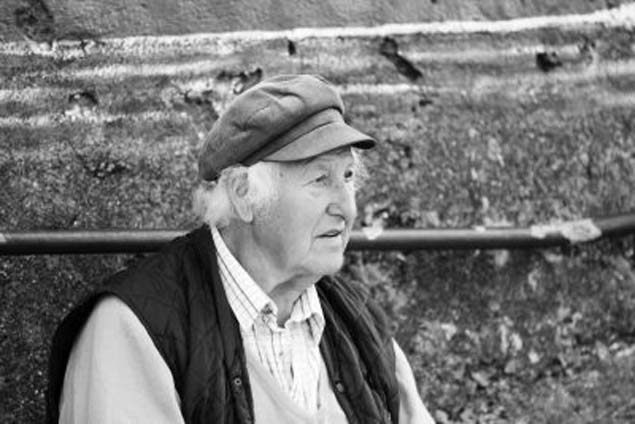 Denis Noonan organised six Round Ireland Races between 2000 and 2010.
Denis Noonan organised six Round Ireland Races between 2000 and 2010.
The effects of the economic recession were hitting very hard as the 2012 race approached, but Theo hung in with total dedication to keep it alive, and it was he who came up the concept of a link to the Royal Irish YC in Dun Laoghaire in time for 2014’s race, which served the big boats particularly well in 2016. Theo in turn retired in February 2018 with Hal Fitzgerald taking over for that year’s race, while for 2020 there has been a spreading of the workload with Hal continuing as Race Director but basically in the demanding backroom role, while the promotional aspects have been taken on by former WSC Commodore Denise Cummins and current Commodore Kyran O’Grady.
 Theo Phelan with Michael Boyd, Commodore RORC, when the latter concluded his second Round Ireland Race in 2016, twenty years after winning overall in 1986
Theo Phelan with Michael Boyd, Commodore RORC, when the latter concluded his second Round Ireland Race in 2016, twenty years after winning overall in 1986 Hal Fitzgerald, a former Commodore of WSC, has been Race Director since 2018
Hal Fitzgerald, a former Commodore of WSC, has been Race Director since 2018
This new setup makes sense because, successful and all as the Round Ireland race has become, it is operating in an increasingly challenging market, with 2020’s plethora of major anniversaries in Irish sailing providing several rival attractions. Thus the Wicklow folk have to spread their international message, and the French market, in particular, has been targeted, with promotional visits to the Paris Boat Show in December (where they received support from offshore superstar Charles Caudrellier), and then in January, Kyran O’Grady was invited to give an event presentation at the annual gala prize-giving of UNCL, the French equivalent to the RORC.
 International promotion. Former WSC Commodore Denise Cummins, France’s Yachtsman of the Year Charles Caudrellier, and WSC Commodore Kyran O’Grady at the Paris Boat Show in December.
International promotion. Former WSC Commodore Denise Cummins, France’s Yachtsman of the Year Charles Caudrellier, and WSC Commodore Kyran O’Grady at the Paris Boat Show in December.
But while the backbone of the SSE Renewables Round Ireland Race in 2020 will continue to be fully-crewed IRC boats, the race also caters for a growing number of Class 40s which find the course well suited to their needs, while as ever Multi-hulls are very welcome and the two-handed division is increasingly significant, particularly if there’s a new emphasis on having female/male crews in line with the thinking towards the new class in the 2024 Olympics.
At the other extreme, after the 1937-built classic Maybird (Darryl Hughes) became the first gaff-rigged boats and the oldest ever to complete the Round Ireland course in 2018, the newly-instated Maybird Mast trophy will honour the race’s most senior boat.
 The clean way ahead, WSC Commodore Kyran O’Grady with Barry Kilcline of SSE Renewables after agreement had been reached for SSE to sponsor the Round Ireland Race. Photo courtesy WSC
The clean way ahead, WSC Commodore Kyran O’Grady with Barry Kilcline of SSE Renewables after agreement had been reached for SSE to sponsor the Round Ireland Race. Photo courtesy WSC
Thus the challenge of racing round Ireland retains its timeless attraction, but how you take it on is something which is constantly being modified and updated by the team in Wicklow Sailing Club. They’re so busy getting on with it that they scarcely seem to notice the prodigious amount of voluntary work which is necessary to keep this unique show on the road. As for the rest of us, we can best acknowledge this by realising that an Irish sailing CV isn’t really complete without at least one Round Ireland Race in its list of achieved projects.



























